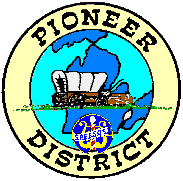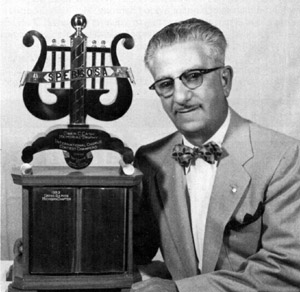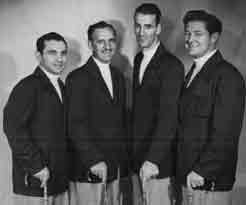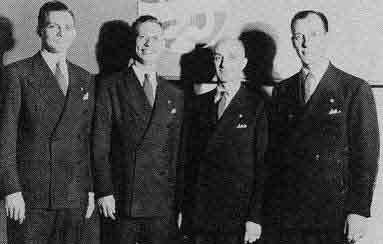


The rules change
"New judging rules, which were approved at the midwinter convention in Toledo in January, set up a system whereby quartets will carry their scores with them, so that their score in the 15 quartet finals will be the total of their semi-finals and finals score, and the rating of the medalist contestants will be the combined scores obtained in the semi-finals, finals, and medalist contests. Up until that time previous scores were not used in determining the champions."
"One other aspect of the rules adopted provided that every number or medley sung in the contests must be entirely different from those previously used in the various convention contests. In other words, a quartet getting into the medalist contest must, by the end of each contest, have sung six different numbers. Other rules were instituted, too numerous to dwell on here."
 Ed Smith |
 Willis Diekema |
"The Michigan District still had five members on the International Board in 1949. In addition to Carroll Adams, who was the resident secretary for the Society and Ed Smith of the Wayne Chapter who was a vice president on the Executive Committee, there was Leonard H. Field of Jackson (term expired in June of 1951), Willis A. Diekema of Holland (term expired in June of 1950) and Roy S. Harvey of Muskegon (term expired in June of 1949). All of these men contributed immensely to the success of the Society at that time. B. F. (Monty) Marsden was elected to the board in 1949 replacing Roy S. Harvey in June and Ed Smith was replaced as vice president on the Executive Committee in June of that year."
"The 1949 regional contest was held in Detroit at Cass Technical High School and the district meeting at the Sheraton Cadillac Hotel. New district officers elected were C.W. Coye of Grand Rapids, president; Frank Brown of Lansing and Mark Roberts of Grosse Pointe, vice presidents; Lou Harrington, secretary, and Horace Conklin of Battle Creek, treasurer. It was at this meeting that the district officers voted to impose a 50-cent per capita levy for the first time. It is interesting to note that the international per capita dues at this time were only $3 per member."
"Eighteen quartets vied for the four spots the district was allocated in the regional contest held on April 30 and May 1. Emerging to win the right to represent the district were the ANTLERS, the CLEF DWELLERS, the GARDENAIRES, the SONGMASTERS, with the DETROITERS as the alternate quartet."
We placed well at 1949 international convention
"The international contest was held in Buffalo in early June of 1949, and Michigan quartets stunned the barbershopping world by placing three in the top five medalist positions and one additional in the finals. The CLEF DWELLERS from the Oakland County Chapter finished second to the International Champion MID STATES FOUR from Chicago. The ANTLERS from Flint finished third, and the SONGMASTERS from Lansing finished fourth. The GARDENAIRES finished in the top ten, adding to the district record."
Ben Landino presents first International Quartet Championship Traveling Trophy at Buffalo
 Landino Quartet Trophy
|
"One other Michigan historical event occurred when Ben Landino, of the Grosse Pointe Chapter, presented the new International Quartet Championship Trophy to the International Champion MID STATES FOUR, at the Buffalo convention. The trophy was to be held each year by the Society's champions who passed it on at the end of their reign. Landino was a master craftsman in shaping sheet bronze, and Al Steiner, also of the Grosse Pointe Chapter, did the engraving. This trophy, which became known as the Ben Landino trophy, was passed on until the international contest in Kansas City in 1989, at which time it was retired. The nine quartets who preceded the MID STATES FOUR as Society champions had their names engraved on the trophy, so that when the trophy was retired, the names of the first fifty quartet champions were inscribed on the trophy. The trophy is now resting in the Society's Heritage Hall Museum at international headquarters in Kenosha, as a sincere tribute to Ben Landino. He also designed and handcrafted the International Chorus Trophy, the story of which will be related later on in this history.
 Interludes
|
"The 1949 Michigan District Quartet Contest was held on October 15, 1949, at the Frederic Pease Auditorium on the Michigan Normal College Campus in Ypsilanti, with Ed Smith as general chairman, and sponsored by the Ypsilanti and Wayne Chapters. The winner was the INTERLUDES (Luman Bliss, tenor; Bill McIntire, lead, Ralph Hand, baritone, and Chet Payne, bass) from Midland, and they were crowned our 1949-1950 District Champions. In second place was the MEN OF ACHORD (Maurice Melcher, Jack Keane, Emil Franz Jr. and Adam Kipfmiller) of Saginaw, and in third place was the SONGMASTERS of Lansing. The NOTE BLENDERS (Swanson, Eby, Cannon and Dubrul) from Oakland County walked off with the Novice Crown. Among the other 13 quartets that competed in this contest, it is noted the intriguing and impressive personnel listing of the LANSING ESQUIRES which was Buffington, Buffington, Huntington and Huntington. This should be worth some sort of prize in any barbershop contest. It is interesting to note also that the prices for the early sessions of the contest were 50 cents per person and $1.20 for the evening session, which included tax.
"As Mark Roberts noted: "Perhaps we should award more prizes, particularly to quartets which overcome obstacles of various kinds to be able to compete. I recall one such effort by a talented group which not only had the tools to take top honors but also had the temporary advantage of my genius as a coach. The five of us with a coterie of rooters, boarded a bus in Detroit and headed for the district contest scheduled for that evening. One of the quartet members sat in the rear of the bus with some jolly friends who produced a bottle of Old Uncle Jed's Cream of the South, or something like that, which was 100 proof on the labelóbut probably 120 proof inside. After a few belts from Old Uncle Jed, our quartet boy was higher than John Glenn ever got and with prospects of staying in orbit much longer. At this point the other members of the quartet took him in hand for purposes of resuscitation. Their efforts were reasonable enough at the start but became more frantic as our destination and contest time grew closer. They opened the bus windows and let the cool breezes blow on him; at every stop they walked him around the bus; in town they plied him with coffee, gave him emetics and would have used a stomach pump if one could have been found. Finally, a cold shower and more fresh air exercises were tried. By this time our friend, instead of being another victim of Old Uncle Jed's concoction, was coherent, reasonably steady on his feet and actually in better condition than the other members of the quartet who were exhausted by their labors. They made it on stage, however, and managed a third place finish which was very good under the circumstances."
New district constitution adopted
"The district meeting, which was held in conjunction with the contest, resulted in the adoption of a new district constitution, which made several changes in the district set-up. Under the plan adopted, delegate's terms of office will begin on July 1, and a House of Delegates was provided. The Board of Directors will now consist of ten area governors (now are called area counselors, but were called area governors then), plus the six officers of the Executive Committee. The area governors were to be elected at a caucus of their respective districts. The six officers of the District Executive Committee consisted of the president, two vice presidents, the international board member, the secretary and the treasurer. The complete list of all the areas set up under the revised 1949 constitution were as follows:
| Area Governor | Chapters | |
Area 1 |
Robert Yerkes Northville |
Dearborn, Detroit, East Detroit, Grosse Point Hamtramck, Milford, Mt. Clemens, Northville Pontaic, Northwest Detroit, Oakland County,Redford, Wayne |
Area 2 |
E. B. Therkelson Belleville |
Dearborn, Detroit, East Detroit, Northville, Grosse Pointe, Hamtramck, Milford, Mt. Clemens, Northville, Pontiac, Northwest Detroit, Oakland County, Redford, Wayne |
Area 3 |
Rush Wyman Lansing | Albion, Battle Creek, Eaton Rapids,Lansing, Jackson |
Area 4 |
Harold Damm Corunna |
Chesaning, Flint, Gratiot County, Holly, Lapeer |
Area 5 |
Luman Bliss Midland |
Bay City, Clare Midland, Mt. Pleasant, Saginaw |
Area 6 |
Loton Wilson Boyne City |
Boyne City, Charlevoix, East Jordan |
Area 7 |
Ferris Freed Traverse City |
Beulah, Big Rapids, Hart, Ludington, Manistee, Reed City, Traverse City |
Area 8 |
E. B. Therkelson Belleville |
Dearborn, Detroit, East Detroit, Northville, Grosse Pointe, Hamtramck, Milford, Mt. Clemens, Northville, Pontiac, Northwest Detroit, Oakland County, Redford, Wayne |
Area 9 |
Tom Straatsma Grand Haven |
Allegan, Holland, Grand haven, Muskegon, Whitehall-Montague |
Area 10 |
M.C. Newman Sturgis |
Benton Harbor, St. Joseph, Dowagiac, Kalamazoo,Mercellus, South Haven, Sturgis, Three Rivers, Vickburg |
 Louis Harrington |
"Another district historical event of note took place in 1949 when in October of that year, Louis R. Harrington, then district secretary, began publishing what is believed to be the first district publication in our Society. There had been notices and letters distributed to all chapter members previous to this; but this is the first time an organized publication was put out on a bi-monthly basis and it was named The Michigan Troubadour. Yes, it is the predecessor of our present day Pioneer District Troubadour. In the beginning, copies for each member were mailed to each chapter secretary, and then were distributed at their chapter meetings. The first editions were typed on mimeograph, and were one-sided only. Surprisingly enough, the first issues contained quite a bit of information for the individual member, and although not as news-filled as today's publication, it was a start in the right direction."
 Harmony Halls
|
"As we leave the Forties, it should be obvious to the reader that Michigan played a very important part in our early Society beginnings. It not only was the biggest district (at the end of 1949 there were 72 chapters with over 2000 members), but we were far ahead of all the other districts in terms of administration, leadership, and musical talent. While we only had one quartet champion nationally
(HARMONY HALLS in 1944), we always placed a number of quartets in the finals and probably had more medalist quartets than any other district up until that time."
[index]
[1946]
[1947]
[1948]
[1949]
[1950]
[Contents]
Page Updated